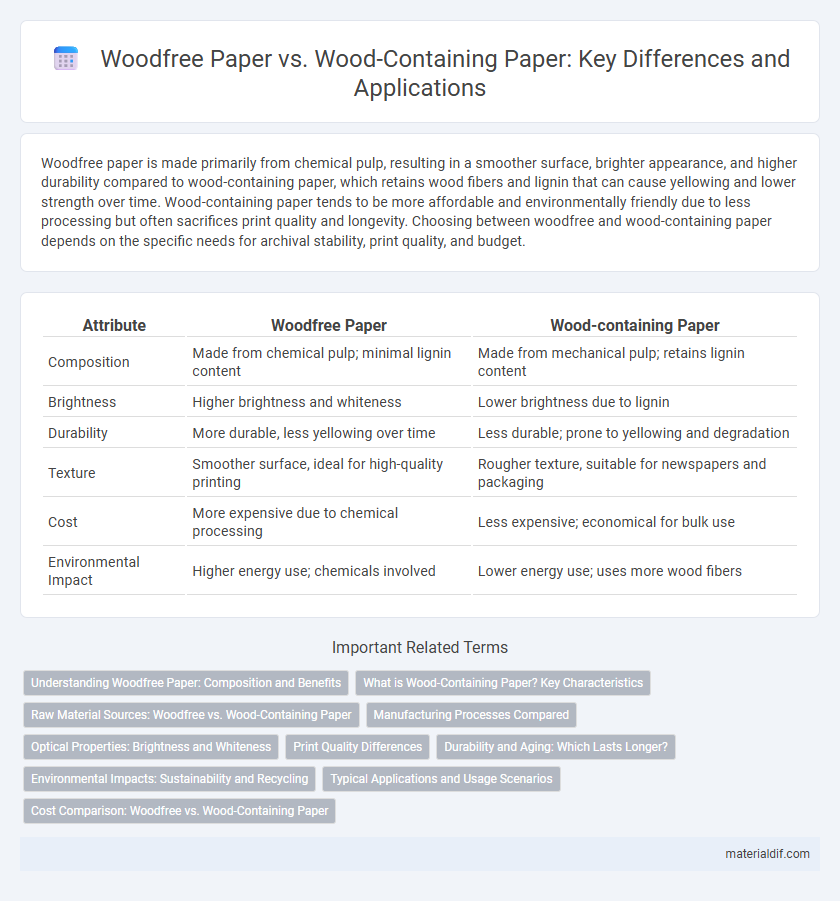Woodfree paper is made primarily from chemical pulp, resulting in a smoother surface, brighter appearance, and higher durability compared to wood-containing paper, which retains wood fibers and lignin that can cause yellowing and lower strength over time. Wood-containing paper tends to be more affordable and environmentally friendly due to less processing but often sacrifices print quality and longevity. Choosing between woodfree and wood-containing paper depends on the specific needs for archival stability, print quality, and budget.
Table of Comparison
| Attribute | Woodfree Paper | Wood-containing Paper |
|---|---|---|
| Composition | Made from chemical pulp; minimal lignin content | Made from mechanical pulp; retains lignin content |
| Brightness | Higher brightness and whiteness | Lower brightness due to lignin |
| Durability | More durable, less yellowing over time | Less durable; prone to yellowing and degradation |
| Texture | Smoother surface, ideal for high-quality printing | Rougher texture, suitable for newspapers and packaging |
| Cost | More expensive due to chemical processing | Less expensive; economical for bulk use |
| Environmental Impact | Higher energy use; chemicals involved | Lower energy use; uses more wood fibers |
Understanding Woodfree Paper: Composition and Benefits
Woodfree paper is primarily composed of chemical pulp, which has most lignin removed, resulting in higher brightness, smoothness, and durability compared to wood-containing paper made from mechanical pulp with retained lignin. This composition enhances print quality and longevity, making woodfree paper ideal for premium books, magazines, and office stationery. Its lower lignin content also reduces yellowing over time, ensuring better archival stability.
What is Wood-Containing Paper? Key Characteristics
Wood-containing paper, also known as mechanical or groundwood paper, is produced using wood pulp that retains lignin, resulting in a higher yield but lower durability and yellowing over time. It is characterized by a rougher texture, higher opacity, and cost-effectiveness, making it ideal for newspapers, catalogs, and packaging. Compared to woodfree paper, wood-containing paper offers faster production and stronger mechanical properties but lacks the brightness and longevity required for high-quality printing applications.
Raw Material Sources: Woodfree vs. Wood-Containing Paper
Woodfree paper is primarily made from chemical pulp, where lignin and other impurities are removed during processing, resulting in higher brightness and durability. Wood-containing paper uses mechanical pulp, which retains lignin and fibers from wood, offering cost efficiency but lower quality and printability. The choice of raw materials significantly affects the paper's opacity, strength, and suitability for various applications.
Manufacturing Processes Compared
Woodfree paper is produced using chemical pulping methods that remove lignin from wood fibers, resulting in higher purity and smoother texture, while wood-containing paper relies on mechanical pulping that retains lignin, making the process faster and less costly but yielding lower quality. The chemical pulping process in woodfree paper involves cooking wood chips with chemicals such as sodium hydroxide and sodium sulfide to separate cellulose fibers, whereas wood-containing paper uses grinding or refining techniques to mechanically separate fibers without significant chemical treatment. These manufacturing differences impact the paper's brightness, durability, and suitability for printing applications, with woodfree paper preferred for high-quality documents and wood-containing paper used for packaging and newsprint.
Optical Properties: Brightness and Whiteness
Woodfree paper exhibits superior brightness and whiteness compared to wood-containing paper due to the absence of lignin and mechanical pulp, which cause yellowing and reduced reflectance. Brightness in woodfree paper typically reaches above 90% ISO, enhancing print clarity and color vibrancy. Whiteness levels, influenced by optical brightening agents (OBAs), are also higher in woodfree paper, making it the preferred choice for high-quality printing applications.
Print Quality Differences
Woodfree paper, produced from chemical pulp, offers superior print quality due to its smoother surface and higher brightness, enabling sharper, more vibrant images and text. In contrast, wood-containing paper, made from mechanical pulp, has a rougher texture and lower opacity, which can lead to less crisp print results and potential ink absorption issues. These differences significantly impact the final appearance, with woodfree paper preferred for high-quality printing applications requiring detailed graphics and clear legibility.
Durability and Aging: Which Lasts Longer?
Woodfree paper, composed primarily of chemical pulp with minimal lignin content, offers superior durability and aging resistance compared to wood-containing paper, which includes mechanical pulp retaining lignin that causes faster yellowing and brittleness over time. The absence of lignin in woodfree paper reduces acid formation, enhancing its archival quality and longevity. Consequently, woodfree paper is preferred for documents requiring long-term preservation due to its stable physical and chemical properties.
Environmental Impacts: Sustainability and Recycling
Woodfree paper, made primarily from chemical pulp, offers higher recyclability and reduced environmental impact due to fewer lignin and extractives, which minimizes pollution and enhances paper quality. In contrast, wood-containing paper uses mechanical pulp, resulting in higher lignin content that complicates recycling and accelerates paper degradation, increasing waste and environmental footprint. Sustainable forestry practices and advanced recycling technologies are critical for mitigating the ecological effects of both paper types, supporting circular economy goals in the paper industry.
Typical Applications and Usage Scenarios
Woodfree paper is commonly used in high-quality printing applications such as books, magazines, and office stationery due to its smooth texture and durability. Wood-containing paper, often more affordable and with higher opacity, is preferred for packaging, newspapers, and general-purpose printing where cost efficiency is critical. Both paper types suit different usage scenarios based on printing quality requirements and budget constraints.
Cost Comparison: Woodfree vs. Wood-Containing Paper
Woodfree paper generally incurs higher production costs due to the extensive chemical pulping and bleaching processes required to remove lignin, resulting in a smoother, higher-quality finish. Wood-containing paper is more cost-effective, utilizing mechanical pulping that preserves lignin and reduces manufacturing expenses, making it suitable for budget-conscious applications. The price differential reflects the trade-off between durability, print quality, and economic feasibility in paper selection.
Woodfree paper vs Wood-containing paper Infographic

 materialdif.com
materialdif.com